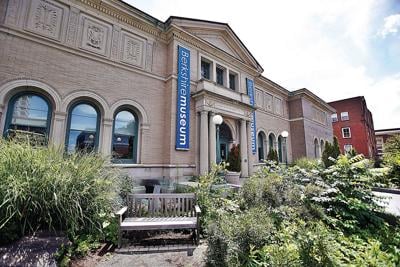PITTSFIELD — Two iconic paintings by Norman Rockwell and other artworks owned by the Berkshire Museum can be sold as planned, after the struggling nonprofit prevailed Tuesday in a Berkshire Superior Court legal challenge.
Judge John Agostini ruled that plaintiffs in two civil actions, and the state Attorney General's Office itself, failed to make their cases to halt a large-scale deaccession by the museum.
The judge is unsparing in his view that the Attorney General's Office conducted an anemic review of the art sale after it was notified about it by the museum in June.
Though not initially a plaintiff, the office filed an emergency motion Nov. 1 to be made one by the court, which Agostini allowed.
All original plaintiffs in two lawsuits were found by Agostini to lack legal standing to challenge the art sales.
In his 25-page decision, Agostini devotes 15 pages to faulting the showing by the Attorney General's Office, suggesting it was "dragged into the litigation."
"The AGO's initial indifference to this litigation, compounded with its later faint-heartedness, strongly suggests that the AGO ... has little expectation of discovering evidence to support its concerns," the judge wrote. "In this litigation, the AGO is a reluctant warrior."
Agostini scolded the office for failing, as he saw it, to provide "any other theory by which the proposed auction would violate the law of public charities."
"It is bewildering that the AGO would seek such an injunction, at such a cost, when its investigation has uncovered no evidence of bad faith, no conflict of interest, no breach of loyalty, no express gift restrictions, and yielded unconvincing evidence of implied gift restrictions or a breach of reasonable care," Agostini wrote.
Emily Snyder, a spokeswoman for the Attorney General's Office, said officials were reviewing the decision.
Agostini's decision ends by saying it was his court's duty to "act dispassionately and decide cases solely on the legal merits of the claims presented."
Those challenging the sales still have legal options, even five days before the two Rockwell paintings go up for sale. But the odds are long, one legal expert notes, in pursuing relief through either the Massachusetts Appeals Court or the Supreme Judicial Court.
As attorneys who fought the sale take stock, they will be hard-pressed to find anything in the decision that favors their arguments.
Big win
The decision is a big win for the museum and comes nearly four months after trustees announced a new direction for the 114-year-old South Street institution.
Museum leaders say they acted to sell the works after determining that the 39 South St. facility could close within eight years unless it manages to stabilize its books.
The museum, founded in 1903 by Dalton industrialist Zenas Crane, says it has been running a roughly million-dollar yearly deficit.
After working with a consultant, museum trustees decided to sell works from their collection and apply the proceeds to a capital project and to expand its endowment to roughly $40 million.
The trustees' decision to sell art "was not unreasonable for any reason raised by the Attorney General," the judge said, crediting the board with undertaking a careful review. "That was their duty. Though the Attorney General, and non-governmental plaintiffs, and perhaps many in the public might disagree with the resulting decision, the law does not hold the Trustees to a standard of popular or political approval."
The museum can now proceed with a series of sales at Sotheby's in New York City that start Monday and continue through next week. The museum plans to use up to $60 million in auction proceeds to expand its endowment and to shift its focus to science and nature programming.
The case has drawn national attention and is considered precedent-setting because it may be the largest such deaccession to date in the museum world in which proceeds would be applied in large part to operational expenses.
In statements released minutes after the judge's decision was made public, the museum and Sotheby's both noted that the finding supports the steps taken by the museum's trustees to confront long-standing financial problems.
Elizabeth McGraw, the trustees president, summoned the name and legacy of the museum's founder.
"We are grateful the judge recognized the care and diligence the board exercised in arriving at this decision, and that today's decision will ensure we can move forward," McGraw said in the statement. "Zenas Crane created this museum to provide his less well-traveled neighbors with what he termed `a window on the world.' We're working to keep that window open."
Briefs filed by the Attorney General's Office within the last week criticized trustees for not honoring their "duty of care" for the museum. Agostini did not find that persuasive.
McGraw said Tuesday her board performed its duty.
"We believe we acted consistent with our responsibility to this community and our collections, to keep this museum open now and strengthen it for generations to come," she said.
Sotheby's said it was pleased to have the court affirm that trustees acted in good faith.
Despite the fact that Agostini has been deliberating since Nov. 1, the auction house continued to market works from the museum collection, including two paintings by Norman Rockwell featured in a special exhibit at its Manhattan headquarters.
"We are looking forward to successful auctions beginning next week that will ensure a bright future for the Berkshire Museum in support of the community of Pittsfield and Western Massachusetts," the Sotheby's statement said.
Though the museum first said it would sell 40 works from its collection, that number was reduced after the state Attorney General's Office signaled that it viewed the sale of works acquired before 1932 as improper.
The judge's decision, however, says no restrictions apply to the 40 works the museum seeks to sell — which has been the museum's contention from the beginning.
Opponents react
Members of the Save the Art-Save the Museum group, which opposes the sale of artworks, expressed dismay over the decision.
"Save the Art-Save the Museum is disappointed in today's ruling ... and is waiting for a response from the Attorney General's Office," the group said in a statement provided by Kimberly Rawson.
The group, which has more than 2,000 members on two Facebook pages, has been raising money to offset legal costs by sale opponents. As of Tuesday it had raised more than $20,000 in online and local fund drives, Rawson said. An online petition against the auctions has generated 1,700 signatures.
Agostini concedes that his finding means that "timeless works by an iconic, local artist will be lost to the public in less than a week's time."
He continues, "No doubt many will be disappointed in this outcome, and they may take little comfort knowing that, in their loss, the rights of a charitable board to make thoughtful decisions to steer its charity through troubled times have been vindicated."
Attorney Nicholas M. O'Donnell represented three plaintiffs, all of whom were found by Agostini to lack standing.
"My clients had certainly hoped for a different outcome, but we are reviewing the decision and considering my clients' options," O'Donnell said.
O'Donnell represented James and Kristin Hatt and Elizabeth Weinberg, all of Lenox.
Michael Keating, the attorney for plaintiffs in the suit filed Oct. 20 — including three sons of Rockwell, Pittsfield artist Tom Patti and four other Berkshire County residents — could not be reached for comment.
Key points
Agostini writes that it was apparent during a two-hour Berkshire Superior Court hearing Nov. 1 that plaintiffs in the case lacked needed legal standing.
The judge questions steps taken up to and including that hearing by the Attorney General's Office.
Hours after that hearing ended, the office filed an emergency motion asking Agostini to allow it to be substituted as a plaintiff, if he decided that the original plaintiffs did not have proper standing to bring the action.
In his decision, Agostini chastises the office for registering only "concerns" about the art sale and not bringing a convincing case against it.
"I suspect that if the other plaintiffs had not filed suit, the AGO would not have initiated any litigation," Agostini writes.
Elsewhere, the judge observes that the office appeared to do nothing to push back against the sale.
"As the clock was ticking down in September and October, the AGO took no steps to intervene or even express dissatisfaction with the planned auctions to the Museum," Agostini writes.
The judge says while all agree the museum faces financial challenges, people differ on the extent of the stress. He states that over two years trustees took pains to find the right answers to their money problems.
"The Trustees' deliberate, two-year decision-making process demonstrates that they were mindful of the donors and the community in that they did not disregard the collections management policy in haste," he writes.
In other parts of the decision, Agostini makes the following points:
- While an 1871 state statute mentions works remaining in Pittsfield, its wording does not restrict sales today.
- Plaintiffs do not have standing to challenge how trustees run the museum — through claims of breach of contract or breach of fiduciary duty — simply by virtue of being members or living in the county.
- Though Norman Rockwell likely held fond feelings for the Berkshire Museum, the museum's mention in a 1958 letter to the artist that his work "Shuffleton's Barbershop" would become part of its "permanent collection" does not mean the painting could never be sold.
- The Rockwell sons lack standing as principal beneficiaries of their father's estate; only the estate itself could seek standing.
- Only the Attorney General's Office can intervene on how a public charity like the museum goes about its affairs.
- Though the attorney general's legal brief faulted the museum for violating its collections policy, that was insufficient to stand in the way of a sale. "Indeed," the judge writes, "there is nothing requiring the Museum to even have a collections management policy at all."
- While the art and museum world stand against the deaccession of art to raise money for operations, that is not a legal barrier.
"Deaccessioning has become a necessary evil in the museum industry due in large part to loss of funding and economic upheaval," Agostini writes.
Larry Parnass can be reached at lparnass@berkshireeagle.com, at @larryparnass on Twitter and 413-496-6214.
Agostini Decision on Berkshire Museum Art Sale by The Berkshire Eagle on Scribd


